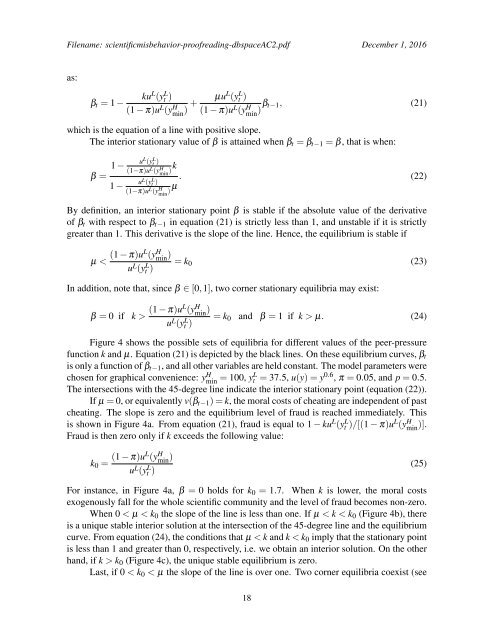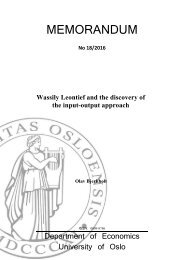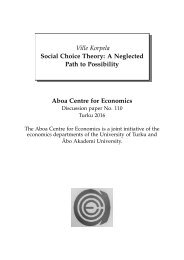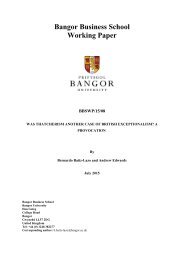Cheat Perish? A Theory Scientific Customs
n?u=RePEc:tut:cccrwp:2016-03-ccr&r=hpe
n?u=RePEc:tut:cccrwp:2016-03-ccr&r=hpe
You also want an ePaper? Increase the reach of your titles
YUMPU automatically turns print PDFs into web optimized ePapers that Google loves.
Filename: scientificmisbehavior-proofreading-dbspaceAC2.pdf December 1, 2016<br />
as:<br />
β t = 1 −<br />
ku L (yt L )<br />
(1 − π)u L (y H min ) + µu L (yt L )<br />
(1 − π)u L (y H min )β t−1, (21)<br />
which is the equation of a line with positive slope.<br />
The interior stationary value of β is attained when β t = β t−1 = β, that is when:<br />
β =<br />
1 − uL (y L t )<br />
(1−π)u L (y H min )k<br />
1 − uL (y L t )<br />
(1−π)u L (y H min )µ . (22)<br />
By definition, an interior stationary point β is stable if the absolute value of the derivative<br />
of β t with respect to β t−1 in equation (21) is strictly less than 1, and unstable if it is strictly<br />
greater than 1. This derivative is the slope of the line. Hence, the equilibrium is stable if<br />
µ < (1 − π)uL (y H min )<br />
u L (y L t )<br />
= k 0 (23)<br />
In addition, note that, since β ∈ [0,1], two corner stationary equilibria may exist:<br />
β = 0 if k > (1 − π)uL (y H min )<br />
u L (y L t )<br />
= k 0 and β = 1 if k > µ. (24)<br />
Figure 4 shows the possible sets of equilibria for different values of the peer-pressure<br />
function k and µ. Equation (21) is depicted by the black lines. On these equilibrium curves, β t<br />
is only a function of β t−1 , and all other variables are held constant. The model parameters were<br />
chosen for graphical convenience: y H min = 100, yL t = 37.5, u(y) = y 0.6 , π = 0.05, and p = 0.5.<br />
The intersections with the 45-degree line indicate the interior stationary point (equation (22)).<br />
If µ = 0, or equivalently v(β t−1 ) = k, the moral costs of cheating are independent of past<br />
cheating. The slope is zero and the equilibrium level of fraud is reached immediately. This<br />
is shown in Figure 4a. From equation (21), fraud is equal to 1 − ku L (y L t )/[(1 − π)u L (y H min )].<br />
Fraud is then zero only if k exceeds the following value:<br />
k 0 = (1 − π)uL (y H min )<br />
u L (y L t )<br />
(25)<br />
For instance, in Figure 4a, β = 0 holds for k 0 = 1.7. When k is lower, the moral costs<br />
exogenously fall for the whole scientific community and the level of fraud becomes non-zero.<br />
When 0 < µ < k 0 the slope of the line is less than one. If µ < k < k 0 (Figure 4b), there<br />
is a unique stable interior solution at the intersection of the 45-degree line and the equilibrium<br />
curve. From equation (24), the conditions that µ < k and k < k 0 imply that the stationary point<br />
is less than 1 and greater than 0, respectively, i.e. we obtain an interior solution. On the other<br />
hand, if k > k 0 (Figure 4c), the unique stable equilibrium is zero.<br />
Last, if 0 < k 0 < µ the slope of the line is over one. Two corner equilibria coexist (see<br />
18





